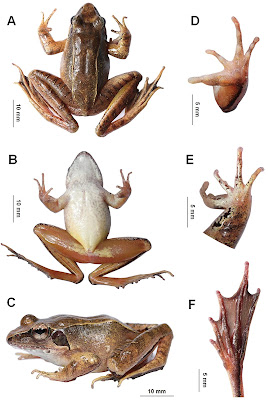 |
| Rana wuyiensis Wu, Shi, Zhang, Chen, Cai, Hoang, Wu & Wang, 2021 |
Abstract
A new species of the frog genus Rana sensu lato from Wuyi Mountain, Fujian Province, China is described. Molecular phylogenetic analyses clustered the new species into the R. johnsi group and indicated that it was genetically divergent from its closely related species. The new species could be distinguished from its congeners by a combination of the following characters: body size medium, SVL 41.4–45.6 mm (42.9 ± 1.9 mm, n = 4) in adult males and 47.6–50.3 mm (n = 2) in adult females; adult male with a pair of internal subgular vocal sacs; lateroventral grooves present on tip of toes; webbing on fourth toes reaching the tip of toe; transverse skin ridges distinctly present on the dorsal surface of thigh and tibia, the number large (mean 26.5 ± 2.7, range 22–29, n = 6); breeding males possess creamy white nuptial pad with tiny velvety spines on the dorsal surface of the first finger, divided into three parts.
Keywords: Molecular phylogenetic analyses, morphology, Rana, taxonomy
 |
| Figure 4. Photos of the holotype CIB WY20200913003 of Rana wuyiensis sp. nov. in life A dorsal view. B ventral view C lateral view D ventral view of hand E dorsal view of hand F ventral view of foot. |
Rana wuyiensis sp. nov.
Diagnosis: Rana wuyiensis sp. nov. is distinguished by a combination of the following morphological characters: body size medium, SVL 41.4–45.6 mm (42.9 ± 1.9 mm, n = 4) in adult males, and 47.6–50.3 mm (n = 2) in adult females; lateroventral grooves present on tip of toes; transverse skin ridges distinctly present on the dorsal surface of thighs and tibias, the number large (mean 26.5 ± 2.7, range 22–29, n = 6); adult male with a pair of internal subgular vocal sacs; webbing on fourth toes reaching the tip of toe; breeding males possess creamy white nuptial pad with tiny hoar velvety spines on the dorsal surface of the first finger, divided into three parts.
Etymology: The specific name wuyiensis is in reference to the type locality, Wuyi Mountain, Fujian Province, China.
Suggested common name: Wuyi Brown Frog (in English),
Wuyi Lin Wa (in Chinese; 武夷林蛙).
Distribution and ecology: Currently, Rana wuyiensis sp. nov. is known from Wuyishan National Park, Wuyishan City, Fujian Province, China. In our surveys from 2017 to 2021, the species was found only at one site. All individuals of the new species used in this work were collected from a stream and nearby grassland under the evergreen broad-leaf forest (Fig. 7). Six adult individuals and some very small tadpoles at early stages of development were found in the late August and early September. Only relative larger and middle-staged tadpoles were collected in the early November. This suggests that the breeding season of this species may begin in July or early August.
 |
| Figure 7. Habitats of Rana wuyiensis sp. nov. in the type locality, Wuyi Mountain, Fujian Province, China A landscape of montane forests in the type locality B a mountain stream in the type locality. |
Yanqing Wu, Shengchao Shi, Huiguang Zhang, Weicai Chen, Bin Cai, Van Chung Hoang, Jun Wu and Bin Wang. 2021. A New Species of the Genus Rana sensu lato Linnaeus, 1758 (Anura, Ranidae) from Wuyi Mountain, Fujian Province, China. ZooKeys. 1065: 101-124. DOI: 10.3897/zookeys.1065.67005
